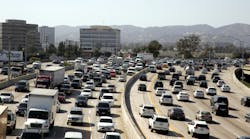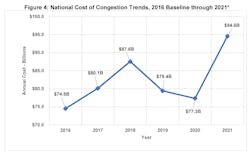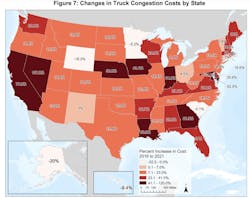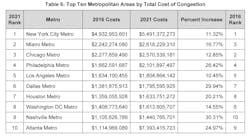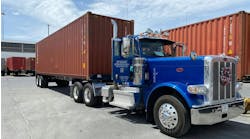Traffic congestion caused the average commuting driver to lose 51 hours in 2022, according to the 2022 INRIX Global Traffic Scorecard. This additional time on the road also cost drivers an extra $869 in lost time, and these traffic delays cost the country $81 billion. The numbers are up from 2021, which saw 36 hours lost due to traffic, an additional $564 spent in lost time, and a cost of $53 billion to the country overall.
In trucking specifically, the cost of congestion in 2021 was more grim. Congestion cost the trucking industry $94.6 billion in 2021, according to the American Transportation Research Institute's "Cost of Congestion to the Trucking Industry: 2023 Update" report. This is the highest amount ATRI has yet to record through its research initiative. The increase can be attributed to the effects of COVID-19, "with high GDP growth and freight demand borne from record levels of consumer spending," ATRI reports.
By documenting the impact of congestion on national, state, and metropolitan levels, ATRI, using 2016 figures as a baseline, calculated the congestion cost from 2017 to 2021, analyzing operational costs, truck volumes, and truck speed.
"Over the last several years, our industry has experienced some of the most dramatic increases in operating costs, including fuel, labor, and equipment," said Michael Lasko, VP of environment, health, safety, and quality at Boyle Transportation. "Imagine how those costs are magnified by sitting still in traffic."
See also: Economic concerns top trucking industry's worries going into 2024
Traffic congestion on a national level
The national impacts of congestion are vast, and "the cost of congestion to the trucking industry is at its highest level to date," according to the report. The congestion cost in 2021 was up $20.1 billion from the 2016 baseline of $74.5 billion. This equates to a 27% increase over the five-year period, which is an increase of "more than twice that of inflation during the same time period," the report stated.
Moreover, 1.27 billion hours were wasted to congestion delays nationally in 2021, which is the "equivalent of more than 460,000 truck drivers sitting idle for a whole year," the study found.
Furthermore, if distributing the total U.S. congestion costs of $94.6 billion across all registered tractor-trailers in the nation, the annual cost of congestion per truck is an average of $6,824.
Not only does congestion adversely affect drivers' time, but the excessive delays and truck idling also affect the environment and the fuel required for daily operations.
"This report estimates that in 2021, 6.793 billion additional gallons of diesel were wasted due to congestion, costing the industry more than $22.3 billion," the report stated. "The CO2 production associated with additional fuel use is substantial at 69 million metric tons."
See also: Getting around traffic bottlenecks to avoid idling
States most impacted by traffic congestion
On a state level, congestion costs were driven by increases in truck volume, a result of "economic growth and increased consumer spending."
The report states that four states alone contributed to 30% of the national congestion cost. The four states with the highest congestion costs were 1) California, 2) Texas, 3) Florida, and 4) New York. Although California had the most significant congestion cost increase, with a growth of $4 billion between 2016 and 2021, another state had the largest increase by percentage. The cost of congestion in Nevada grew a whopping 117.2% from the 2016 baseline, followed by Louisiana (83.3%), Georgia (81.3%), and California (77.9%).See also: California's AB 316 pushes cleaner, safer highways into next decade
Metro areas and the cost of traffic congestion
In metropolitan areas, congestion costs were the highest in New York City, Miami, and Chicago, according to the ATRI report. New York is also home to the nation's second-most congested road, Interstate 27 West—which cost drivers 77 hours in 2021, according to INRIX data. In addition, New York was the most congested metro area in the U.S., with 102 hours lost to congestion and a total cost of $8.3 billion to the city in 2021, according to the INRIX 2021 Traffic Scorecard. Although Miami is listed as the city with the second-highest congestion costs to the trucking industry, the INRIX report listed it as the fifth most congested metropolitan area overall, with 66 hours lost and a cost to the city of $2.6 billion. Chicago is the second-most congested city in the U.S., according to INRIX data, with 104 hours lost and $5.8 billion lost.
New York, Miami, and Chicago are cities with the highest congestion costs, according to ATRI's study; however, congestion cost increases in these three areas were modest, with increases between 11 and 17%. It was smaller metropolitan areas that felt the brunt of the increase in congestion costs. Shreveport (Louisiana) saw a 2021 increase of 53.17% since 2016, the congestion cost in Little Rock, Arkansas, increased by 42.22%, and the congestion cost in Memphis increased by 39.19%. The report explained that these cities contain ports and intermodal hubs that "experienced an increased share of freight volumes" due to the pandemic. Interestingly, these cities weren't listed on INRIX's traffic scorecard report.
See also: Freight rates soft heading into Q4
Congestion, although an expensive pain, isn't all bad news.
"A list of the most congested urban areas in the country is a list of prosperity," stated the UCLA Institute of Transportation in a blog. "In vibrant economies, people have more places to go … Congestion is certainly correlated with economic health and found in vibrant places that offer more opportunity."
However, delays due to congestion can almost triple the shipping cost, the Federal Highway Administration reported.
"Research on the trucking industry has shown that shippers and carriers value transit time in the range of $25 to $200 per hour, depending on the product being carried," stated the FHWA in a report. "The cost of unexpected delays can add another 20% to 250%."
With rising inflation and the high fuel cost, how long can the trucking industry afford to continue running trucks on these highly congested routes?
